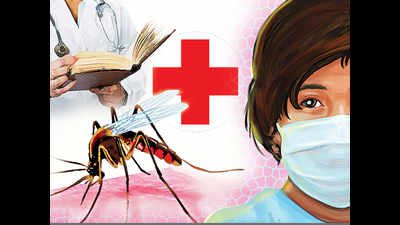Trending
This story is from November 20, 2019
At 659 cases, Pune accounts for 60% of chikungunya burden in state
Extended rainfall, flooding and large-scale construction ensured that Pune (city and rural parts) retained its dubious distinction of recording most chikungunya cases in the state this year too.

Representative image
PUNE: Extended rainfall, flooding and large-scale construction ensured that Pune (city and rural parts) retained its dubious distinction of recording most chikungunya cases in the state this year too.
Of the total 1,086 cases recorded across Maharashtra till October 31 this year, 659 were from Pune (city and rural parts) alone, accounting for 60.68% of the total cases, the state health department’s latest report has revealed.In contrast, the state had 778 people down with the mosquito-borne disease in the same period last year.

The report only considers data of government-designated testing and sentinel centres for mosquito-borne diseases.
In the rural areas, the state has a team of 16,000 multi-purpose workers who make door-to-door visits and take stock of the situation every fortnight. Besides, there is also a network for testing centres for suspected patients.
“Increased surveillance is also one of the reasons for the rise in cases as we have tested more samples of suspected patients this year,” Jagtap added.
Incidentally, the state has also recorded 9,899 dengue cases during the same period (January-October) this year. Dengue and chikungunya are both transmitted by the Aedes aegypti mosquitoes.
When it comes to civic limits, areas under the Pune Municipal Corporation recorded 556 chikungunya cases, most between July and October this year. “Housing societies on the city’s periphery and those in some of the core city areas that reported maximum dengue cases are also the ones accounting for more cases of chikungunya,” a civic health official said.
When contacted on the issue, Sanjeev Wavare, the head of the civic insect control department, confirmed it and said, “It is so because the Aedes aegypti mosquito is the vector for both dengue and chikungunya.”
A total of 97 cases of chikungunya were recorded in rural parts of Pune, while Kolhapur recorded maximum 103 cases of chikungunya in its rural parts this year.
Of the total 1,086 cases recorded across Maharashtra till October 31 this year, 659 were from Pune (city and rural parts) alone, accounting for 60.68% of the total cases, the state health department’s latest report has revealed.In contrast, the state had 778 people down with the mosquito-borne disease in the same period last year.

The report only considers data of government-designated testing and sentinel centres for mosquito-borne diseases.
“Most cases of chikungunya were recorded in September and October this year. Extended rainfall and floods in Kolhapur, Sangli, Satara and flash floods in some areas like Pune provided conducive conditions for the disease-causing mosquito to breed and propagate, resulting in more cases this year,” state entomologist Mahendra Jagtap said.
In the rural areas, the state has a team of 16,000 multi-purpose workers who make door-to-door visits and take stock of the situation every fortnight. Besides, there is also a network for testing centres for suspected patients.
“Increased surveillance is also one of the reasons for the rise in cases as we have tested more samples of suspected patients this year,” Jagtap added.
Incidentally, the state has also recorded 9,899 dengue cases during the same period (January-October) this year. Dengue and chikungunya are both transmitted by the Aedes aegypti mosquitoes.
When it comes to civic limits, areas under the Pune Municipal Corporation recorded 556 chikungunya cases, most between July and October this year. “Housing societies on the city’s periphery and those in some of the core city areas that reported maximum dengue cases are also the ones accounting for more cases of chikungunya,” a civic health official said.
When contacted on the issue, Sanjeev Wavare, the head of the civic insect control department, confirmed it and said, “It is so because the Aedes aegypti mosquito is the vector for both dengue and chikungunya.”
A total of 97 cases of chikungunya were recorded in rural parts of Pune, while Kolhapur recorded maximum 103 cases of chikungunya in its rural parts this year.
End of Article
FOLLOW US ON SOCIAL MEDIA










